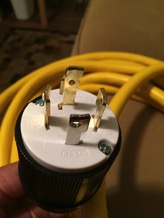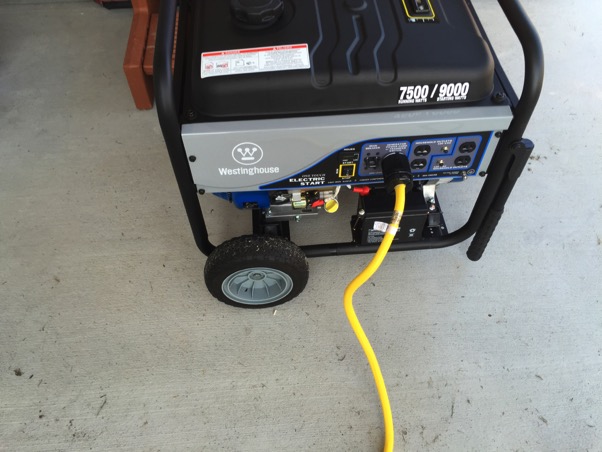How To Install A Back Up Generator at Home
I recently moved to Eastern North Carolina right in Hurricane Alley and felt the need to have a secondary electrical generator at home. I managed to find a really inexpensive 3200 watt generator from Harbor Freight

and when the power went out I ran multiple extension cords into the house, through a doggy door and one cord through the door which enters the garage to power the deep freezer. This got me to thinking how unacceptable this would be during the dead of winter during a power outage. Not only that I felt I was kind of limited in power and couldn’t power enough items. Although the basic needs were met I didn’t think I could provide heat and definitely not air conditioning. Lights, and refrigerators and TV’s and radios.
Hey, that ain’t bad when you have nothing but it can always be much, much better. The first issue at hand was to power the generator up outside, with no extension cords running through the home and no open doors. Closed doors mean a reduction in sound as well from gas powered generators which are, well, noisy.
So I did all the requisite homework for a few days on the internet and opted for a Westinghouse Generator which are very highly rated, especially the WH7500E. Then I made sure before I purchased it that it would provide enough power for my needs. You can check that here with their handy wattage calculator. There are a million calculators on line. I only settled on this one because it was for the same brand I had considered purchasing. Seemed that the WH7500E was the one.
I bought it here on Amazon.com Seems my timing was good now because the price just went way up. I paid about $820.

Anyway I bought this based on the reviews. It is relatively quiet, has a large gas tank, runs for almost 13 hours, and has high reliability and dependability marks. Reviews are great for this generator. Shipping was free because I’m a Prime Member at Amazon as well. So I got a fantastic deal.
Now what has to be done is the generator must be wired into the Main Circuit Breaker Box for your home. There are a few ways to do that but first some basics. Your home has 240 volt service coming into it. There are 2 separate 120 volt legs, a neutral, and a ground. Use both 120 volt legs and you have 240volt service for big items like electric dryers.
In order to power both 120 volt legs and power your entire circuit breaker box you’ll need a 2 pole circuit breaker (each pole carrying 120 volts), and in my case a 30 amp breaker. If you have a larger generator you may need a 50 amp breaker. This is why the world has electricians. If you don’t know. HIRE AN ELECTRICIAN.
So now the issue becomes safety. If your power goes out and then you pump 240 volts into your breaker box and then the power comes back on…….well……..240 + 240 = 480 volts. BANG. POW. SMOKE.
If you power up your home via generator and the main circuit breaker is on you’re sending free power to your neighbor AND to the guy who might be trying to fix your power problem. HE DOES NOT WANT YOUR FREE POWER. That is referred to as ELECTROCUTION. That is a bad thing.
So again there are a few ways to do this but the cheapest and most reliable and easiest thing to do in the dark is to get an interlock switch. It physically prevents both breakers from being on at the same time. If you are on city power it is impossible to turn on generator power. If you are on generator power it is impossible to throw the main breaker keeping your repair man safe and your neighbors from swiping your power plant.

I have a Square D QO type panel. This is my interlock at Home Depot.
Now the electrician will run 4 wires from your breaker box to your inlet plug which you mount outside the house. In my case in a 30 amp circuit this requires a minimum of #10 wiring. Two hot wires, One neutral, and one ground. The hot wires go to the new 2 pole, 30 amp generator breaker that was installed. The neutral and ground connect to their respective places in the mains box. So you need 10/4 Romex wiring. I found a great little diagram on the internet that demonstrates this.

Here is the inlet plug I have. It is a Reliance Controls PBN30 It is a 4 pin 240 volt Twist Lock connector and looks like this when mounted:

Now you need a generator cable, again a minimum of 10/4 wiring with NEMA 14R-30 and 30P connectors. (4 prong twist lock, male and female).
I bought mine at Lowes for about $90 for a 25′ cord. Yes, they are expensive. They look like this:


Now connect your male end of the generator to the 240 volt outlet on your generator.

Then connect it to your inlet box.

Now turn off EVERY SINGLE BREAKER IN YOUR BOX. When you turn off the main circuit breaker to the house the interlock will fall allowing you to turn on the Generator breaker. You may now start your generator and turn on the output. This supplies power to your mains box. MAKE SURE YOUR GENERATOR EXHAUST ISN’T POINTED AT THE BACK DOOR and you have plenty of ventilation. You may then turn on the breakers ONE AT A TIME, listening to the generator to make sure it isn’t choking or stalling. This is the sign of an overload condition. Don’t turn on luxury items. I have a hot tub. I can think of no reason to ever power my hot tub during a power outage. Just don’t do it. You probably don’t need to dry clothes 1 hour into a power outage so no reason to turn on the washer dryer. You get me, right?
When the city power comes back on, reverse the process. Always be safe. Don’t do this yourself. Hire an electrician. I’m an electrical / electronics tech rep for the Department of Defense. I know how to do this. I HIRED AN ELECTRICIAN. It’s your home for God’s sake. Your kids live here.
By the way my generator powers my whole home and even my central air conditioning works.
As a final touch I added a Reliance Controls THP-108 PowerBack alarm that I got from Amazon from here. When the power goes out and you switch to generator you’ll never know if the power comes back on. What this does is sense, via inductance, the restoration of power and then sends a really loud and annoying audible alarm.
Since no power is really involved I just did it myself. All you have to do is find a way to mount the alarm, I used an old exterior electrical fixture I had laying around and then snake the inductance wire and a ground wire into the circuit breaker box as in the picture below. The green wire hooks to the ground bus and the white wire wraps around one of the two hot wires coming from the meter just before the main circuit breaker. WARNING! Hot is the applicable word here. It is energized. If you’re scared to touch it (you should be) just have the electrician do it when they install the other stuff. I’m not ascared of nothing except ex wives.


When the power goes out though you have to remember to turn it on so it will alarm. It works off a 9 volt battery so be sure to test and change it once in a while.
Last bit of advice. Keep 20 gallons or so of gasoline in the garage and treat it with STA-BIL fuel stabilizer.

john, Great piece on the generator, I like the touch with the alarm…I tried to go to the links in the piece but they didn’t work….The Home depot one for the Generator didn’t work at all…the one for the alarm just flickered every 3-4 seconds and could not be used. I’m pretty sure it’s not my pc. Seems to work on other sites ok.
If you don’t recognize me, I’m Jerry Weigh from the NBARC club, but ,I don’t live up there anymore. My wife and I moved last December to Florida. I may still be listed on the members list.
Jerry, K4GEW ….STAY SAFE.
Hi Jerry. I’ll try to work through the links later. Off helping my daughter move in Charlotte this weekend. Good to hear from you! Florida sounds great. John …… KN4FMV
SOLAR PANELS might need some consideration. The solar inverter should stop feeding energy when utility is off-line. ok. safe. When connected parallel with generator inverter provides power and everything works fine as long as the house consumes more than solar generates. What happens when consumption becomes less than solar can make?? It is not pushing excess to grid.